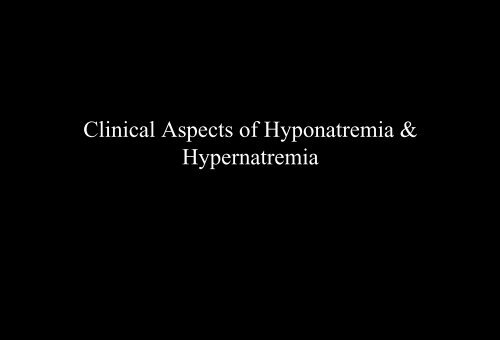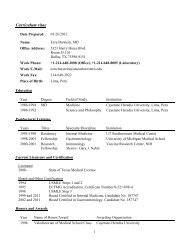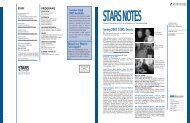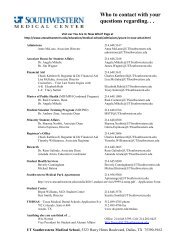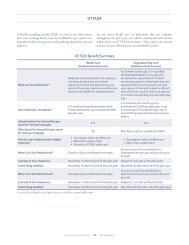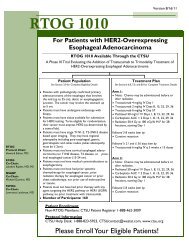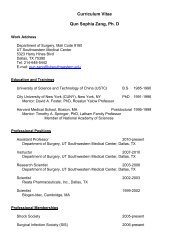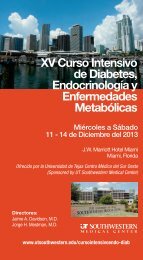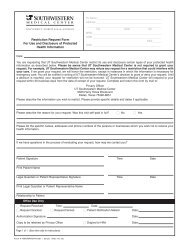Clinical Aspects of Hyponatremia & Hypernatremia - UT Southwestern
Clinical Aspects of Hyponatremia & Hypernatremia - UT Southwestern
Clinical Aspects of Hyponatremia & Hypernatremia - UT Southwestern
- No tags were found...
You also want an ePaper? Increase the reach of your titles
YUMPU automatically turns print PDFs into web optimized ePapers that Google loves.
<strong>Clinical</strong> <strong>Aspects</strong> <strong>of</strong> <strong>Hyponatremia</strong> &<strong>Hypernatremia</strong>
Case Presentation: History62 y/o male is admitted to the hospital with a 3 monthhistory <strong>of</strong> excessive urination (polyuria) and excess waterintake up to a gallon per day. His wife noted that he hadlost weight, became forgetful and irascible.
Case Presentation: Physical ExaminationEmaciated, somnolent 62 y/o man in no acute distress.Multiple signs <strong>of</strong> dehydration were evident including lowblood pressure upon standing (orthostatic hypotension),loss <strong>of</strong> normal skin reslience, sunken eyeballs, and lowintravascular volume. In addition he was confused,disoriented and had reduced level <strong>of</strong> consciousness.
Case Presentation: Laboratory IBlood Tests:Sodium 150 mEq/L (Nl 138-142)Chloride 106 mEq/L (nl 95-100)Kidney Function Decreased 50%Calcium 16.5 mg/dl (Nl 8-10)Urine Tests:Specific gravity 1.008 (Nl for dehydration 1.025-1.035),Urine sodium Na 15 mEq/L (low), Osm 280 mOsm (lowfor dehydration)
Case Presentation: Laboratory II• Serum protein electrophoresis: Abnormal amount <strong>of</strong> pure(monoclonal) immunoglobulin• Bone Marrow Biopsy: Multiple Myeloma- a malignanttumor <strong>of</strong> plasma (immune system) cells that causes– Monoclonal immunoglobulin excess– high blood calcium by break down <strong>of</strong> the skeleton.
• Orthostatic Hypotension• Low urine osmolality• <strong>Hypernatremia</strong>Signs <strong>of</strong> Polyuria due toRenal Concentrating Defect– Excess free water loss– Insufficient free water intake
Polyuria: Differential Diagnosis• Volume Depletion– Diabetes Insipidus• Central• Nephrogenic–Diuretics•Osmotic•Drugs• Normal Volume– Primary Polydipsia
Systemic Consequences <strong>of</strong> Chronic Hypercalcemia(High Blood Calcium Concentration)• Neuro: Altered Mental Status, Muscle Weakness• GI: Anorexia, nausea and vomiting• Renal Concentrating Defect– Polyuria, polydipsia– <strong>Hypernatremia</strong> (coupled with decreased intake <strong>of</strong>water from loss <strong>of</strong> appetite and altered mental status)
Consequences <strong>of</strong> Hypercalcemia:Renal, Fluid and Electrolyte• Volume Depletion• Decreased intake due to anorexia, nausea and vomiting• Nephrogenic diabetes insipidus (NDI) causing free water loss• <strong>Hypernatremia</strong> from Nephrogenic Diabetes Insipidus• Renal Insufficiency• Decreased blood flow to kidney• Calcification <strong>of</strong> the kidney itself
Diabetes Insipidus (DI)• Excessive water loss bythe kidney• Inability <strong>of</strong> kidney toconcentrate the urine– Deficiency <strong>of</strong>Antidiuretic Hormone(ADH)–Central DI– Renal resistance toADHADHNephrogenic DI– Resistance toADHCentral DI– Lack <strong>of</strong>ADHH 2 O
Nephrogenic Diabetes Insipidus:Common Causes• Many chronic renal diseases• Electrolyte disorders• High Blood Calcium Hypercalcemia• Low Blood Potassium Hypokalemia• Drugs– including Lithium, AMP-B, Demeclocycline, Gentamicin, cisplatin, others• Dietary abnormalities, e.g. decreased NaCl or proteinintake
Hyper (High) natremia and Hypo (Low)natremia: Water deficiency and water excessWater ExcessNormal WaterWater DeficiencyNa 130Na 140Na 150
Pathogenetic Mechanisms <strong>of</strong> <strong>Hypernatremia</strong>Condition Serum Sodium ExamplePure Water Loss Na Diabetes InsipidusTBWSodium and Na Osmotic DiuresisWater LossTBWSodium Gain Na Hypertonic NaHCO 3TBW
Central Diabetes InsipidusNormal PersonWater restrictedPatient with Central DIWater RestrictedCortexH 20H 20HighAVPH 20H 20ZeroAVPH 20H 20M edullaUrine Flow LowUosm 1000Urine Flow HighUosm 200
Nephrogenic Diabetes InsipidusNormal PersonWater restrictedPatient with Nephrogenic DIWater RestrictedCortexH 20H 20HighAVPH 20H 20HighAVPH 20H 20M edullaUrine Flow LowUosm 1000Urine Flow HighUosm 250
Hypercalcemia as a Cause <strong>of</strong>Nephrogenic Diabetes Insipidus• Any chronic hypercalemic state• Common cause <strong>of</strong> NDI in Adults• Mild hypernatremia (145-150) typical• Decreased renal function common• Reversible with correction <strong>of</strong> hypercalcemia(unless severe nephrocalcinosis)
Hypercalcemia and NephrogenicDiabetes Insipidus• Hypercalcemia Causes Polyuria• Vasopressin Resistant Concentrating Defect• Direct Effect <strong>of</strong> Calcium onRenal Water Handling• Independent <strong>of</strong> GFR, PTH, Vitamin D, Calcitonin
How does Hypercalcemia causeNephrogenic Diabetes Insipidus?• Decreased delivery <strong>of</strong> solute to the loop <strong>of</strong> Henle(reduced GFR)• Inhibition <strong>of</strong> NaCl transport in thethick ascending limb• Inhibition <strong>of</strong> vasopressin-mediated waterpermeability in the terminal collecting duct
Hypercalcemia and NephrogenicDiabetes InsipidusCa 2+Ca ++• Direct Effect <strong>of</strong> Calciumon Renal water Handling• Vasopressin-ResistantAVPResistanceFree H 2 0 Excretion• Independent <strong>of</strong> GFR,PTH, Vitamin D andCalcitonin
HighAVPNormal PersonWater restrictedH 20H 20H 20Osmotic DiuresisHighAVPNormal person Mannitol InfusionWater RestrictedMH 20H 20H 20MMMNaNaNaMNaMNaNaM M MCortexM edullaMUrine Flow LowUosm 1200Urine Flow HighUosm 400
[2002] Australian International Law Journalextremist “pro-government vigilantes”. 58 Efforts by relatives, lawyers,journalists and human rights organisations to obtain information on“disappeared” individuals usually run into the Byzantine maze <strong>of</strong>government bureaucracy or the solid wall <strong>of</strong> “classified” State securityinformation which gives the government firm ground to use the alibi <strong>of</strong>“matters <strong>of</strong> national security” to effectively forestall inquisition into itsshadowy operations.3.3.2. The Iron Curtain <strong>of</strong> SecrecyConsidering the illegality <strong>of</strong> “disappearances” and political killings,those responsible for them--the people who plan, order, carry out andacquiesce in them--will want to avoid being called to account and bepunished. Secrecy helps to accomplish this. It also helps to allow aprogram <strong>of</strong> “disappearances” and extra-judicial executions to continueby confusing and neutralising the efforts <strong>of</strong> those who would takecorrective action.It is <strong>of</strong>ten the intelligence services which carry out “disappearances”58 See eg ibid 27,35; Amnesty International, Getting Away With Murder: PoliticalKillings and “Disappearances” in the 1990s (1993, London, Amnesty International)33-38.21
Urine Concentration(mOsm/L)Effect <strong>of</strong> Osmotic Diuresis on Uosm16001400120010008006004002000NormalPartial Central DIComplete Central DI0 2 4 6 8 10 12 14Solute Excretion (mOsm/min/1.73 m 2 )
How to determine the cause <strong>of</strong> polyuric states:Water Deprivation and ADH responsiveness• Step 1: Water deprivation• Step 2: Measure Urine Osmolality• Step 3: Administer exogenous dose <strong>of</strong> ADH• Step 4: Repeat Urine Osmolality Measurement toevaluate response to ADH
Differentiating Polyuric States :Dehydration and AVP Stimulation TestsConditionUosm MaxdehydrationUosm Maxafter AVP% Change Uosm IncreaseNormal 1068 ± 69 979 ± 79 -9 ± 3 < 9%PsychogenicPolydipsiaPartialCentral DICompleteCentral DINephrogenicDI738 ± 53 780 ± 73 5 ± 2 < 9%438 ± 34 549 ± 28 28 ± 5 > 9% < 50%168 ± 13 445 ± 52 183 ± 41 >50%124 174 42 < 50%Miller et al. Ann. In. Med 73:721, 1970
Calculating Water Deficit in <strong>Hypernatremia</strong>Due to Pure Water Loss• Serum Na 150, Normal Na 140, 70 kg man• Total Body Water Deficit =BW in kg x 0.6 x [150 -140]14070 x 0.6 x [0.06] = 2.8 LTBW factor:Use 0.6 male0.5 female0.45 elderly


